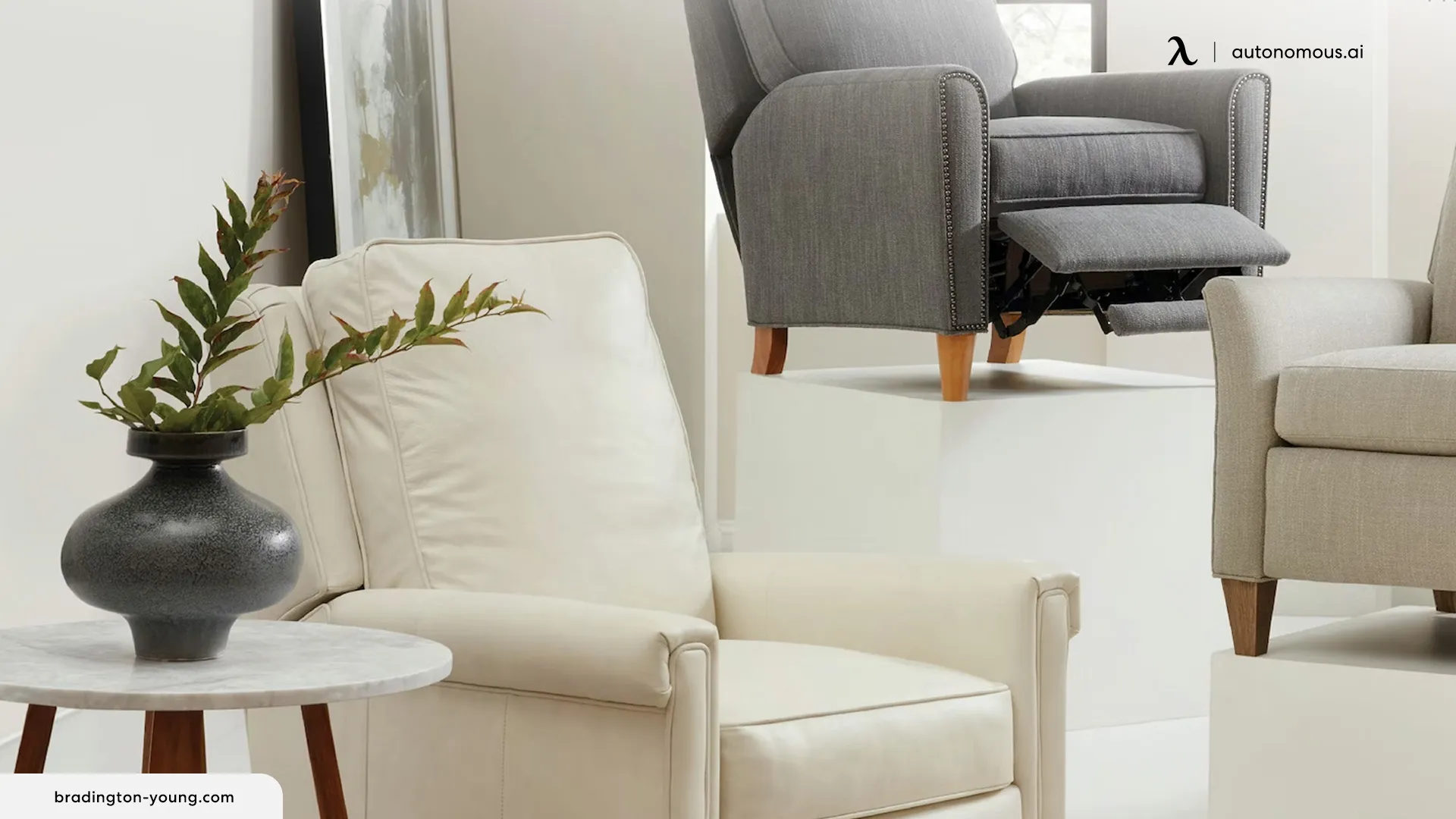
Creating a Recliner Desk Setup for Your Home Office
Table of Contents
The home office has become a staple for many, offering flexibility and convenience. However, traditional office setups often prioritize function over comfort, leading to aches and pains after long work days. Enter the recliner desk setup, a revolutionary approach that combines ergonomic support with the ultimate in comfort - your favorite recliner.
This blog will guide you through building your ideal setup, from selecting the perfect chair and desk combination to incorporating ergonomic principles and personal touches. Whether you're a freelancer or a remote worker, this setup can transform your home office into a sanctuary of productivity and relaxation.
Guide to Setting Up a Recliner Desk
Tired of sacrificing comfort for productivity? A recliner desk setup can offer the best of both worlds. By combining the ergonomic benefits of a traditional office setup with the unparalleled comfort of a recliner, you can create a workspace that truly caters to your needs.
In this section, we'll guide you through the process of setting up your ideal setup:
Step 1: Choose the Right Recliner and Desk Combination
Choosing the right office recliner desk chair is the first step to creating a successful recliner desk setup.
Look for recliners that:
- Offer good lumbar support to help you maintain proper posture.
- Have adjustable reclining angles to allow you to switch positions throughout the day.
- Feature materials that are both durable and comfortable, such as leather or fabric with cushioning.
Ensure your chosen recliner offers enough lumbar support and is adjustable to different angles for comfortable seating. Best recliners for neck pain may provide helpful insights when selecting the right one.
For the desk:
- Opt for a desk with adjustable height options, as it may be helpful to adjust the desk to match the recline angle of your chair. Standing desks with height adjustment can work well in a recliner setup.
- If space allows, consider a desk with an L-shape or one with ample surface area so you can keep essentials within easy reach.
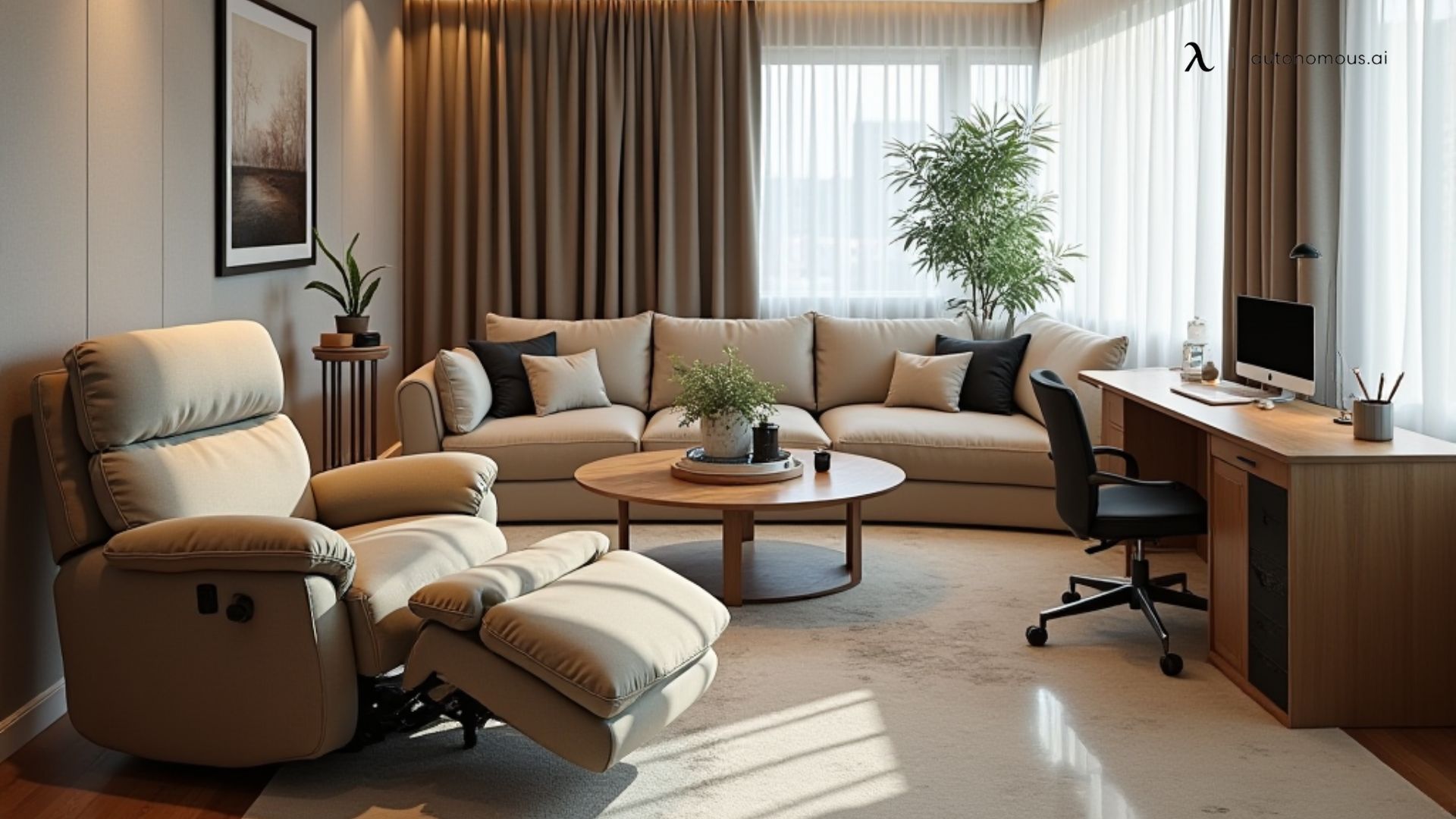
Pro Tip: Pairing a compact, height-adjustable desk with your recliner can offer both versatility and functionality, allowing you to work comfortably regardless of the position you’re in.
Step 2: Consider the Size and Layout of Your Home Office
The layout and size of your home office are key when setting up an office desk recliner. Here are some tips:
- Measure the space: Ensure you have enough room for the recliner to fully extend without hitting walls or other furniture.
- Plan the layout: Ideally, place the recliner at an angle where natural light can reach you, but not directly on your screen. If you lack natural light, be sure to supplement with sufficient lighting.
- Create a flow: Arrange the desk and recliner so that you can easily switch between sitting upright and reclining positions.
If you have a smaller space, opt for a minimalist desk with integrated storage solutions. This can help keep the area organized without adding bulk. For inspiration, explore various home office setup ideas.
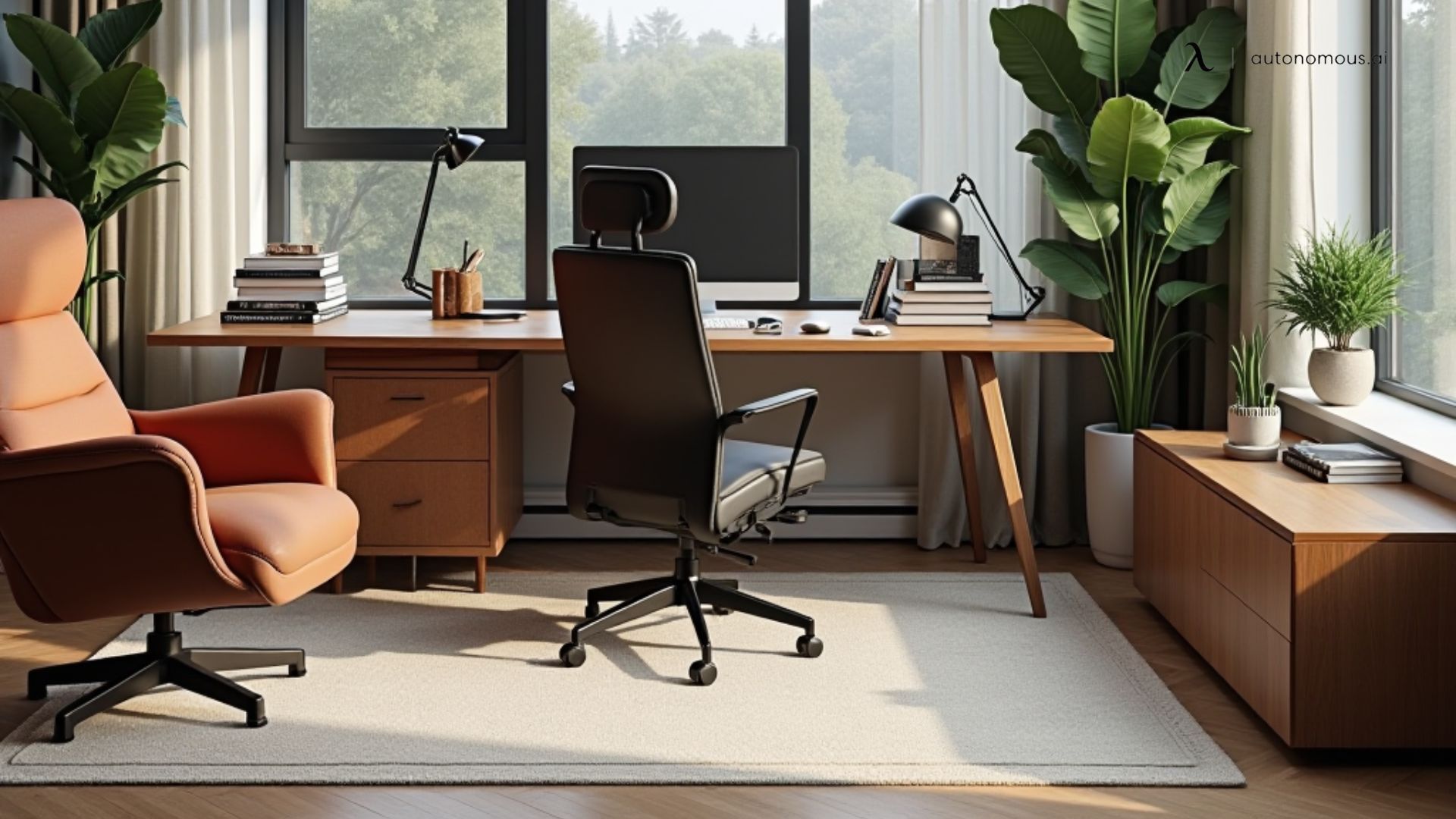
Step 3: Choose the Right Chair and Desk Accessories
Accessories can make or break the comfort of a recliner desk setup. Consider:
- Footrests: These can help support your feet when reclining, improving circulation and reducing strain.
- Monitor arms or stands: Adjustable monitor stands or monitor arms are essential for setting your screen at eye level, preventing neck strain.
- Laptop stand: If you’re working on a laptop, a stand can help keep your device at a comfortable height, especially when reclining.
- Side tables or trays: These can provide extra surface area for items like a mouse, keyboard, or even a drink, without cluttering your main desk space.
Choose accessories that fit your space and are easily adjustable or movable to accommodate different reclined positions.
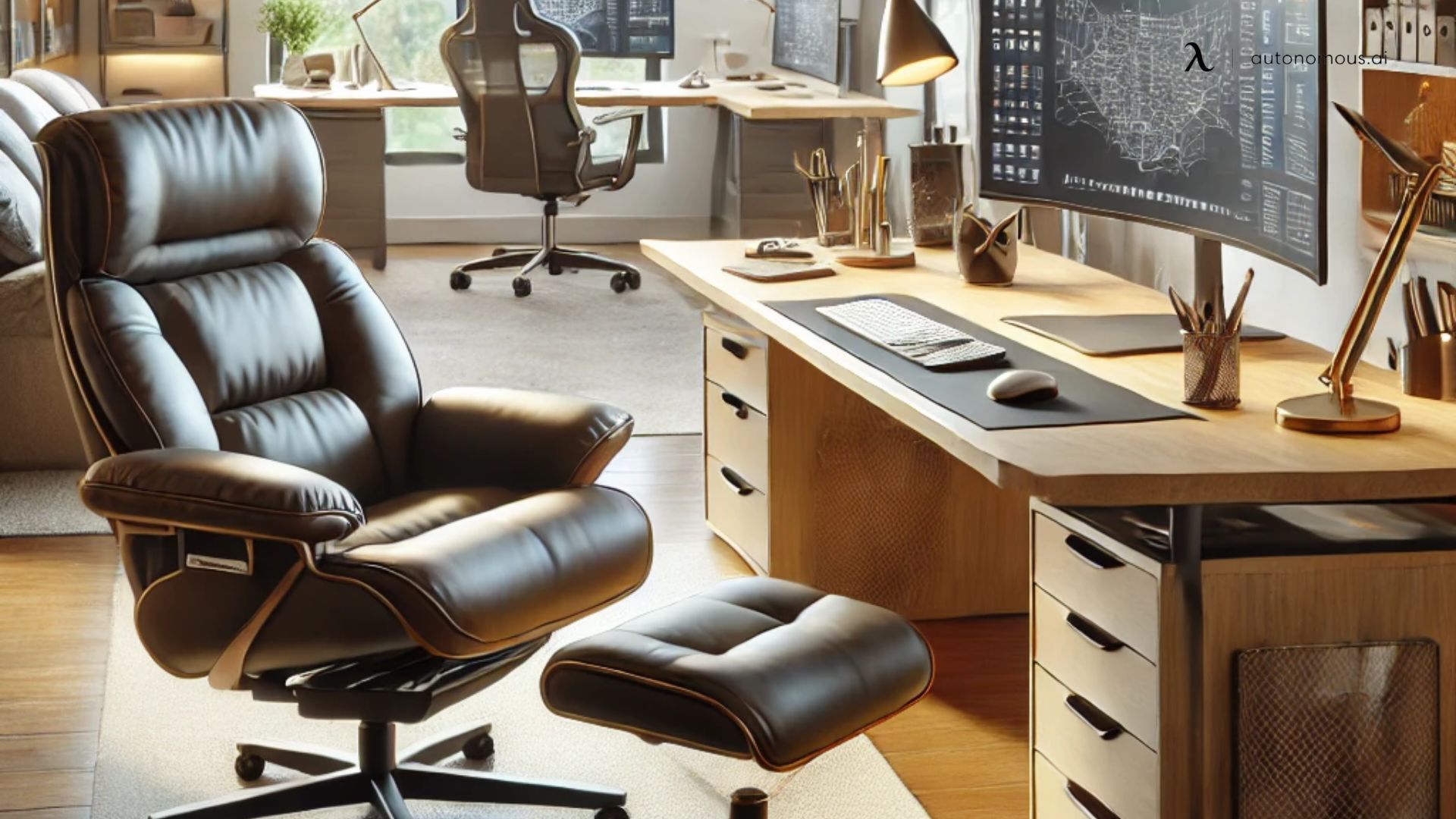
Step 4: Set Up Your Workspace for Optimal Comfort and Ergonomics
Creating an ergonomic setup involves more than just a comfortable recline position and seating. Follow these tips for better ergonomics:
- Position your screen: Keep your monitor at eye level and about an arm’s length away. This will help prevent eye strain and maintain a comfortable neck position.
- Use a recliner with good lumbar support: Lumbar support can alleviate back pain and promote better posture. Many recliners come with built-in lumbar support, but you can also purchase separate cushions if needed.
- Keyboard and mouse positioning: Keep your keyboard and mouse close enough to reach comfortably without stretching. Ergonomic keyboard trays can help you keep your wrists in a neutral position while typing.
You may also want to consider an adjustable standing desk for those times when you want to take a break from sitting. Having the flexibility to alternate between sitting and standing can improve your overall health and productivity.
Step 5: Add Lighting and Other Amenities to Enhance Your Workspace
Good lighting is essential for any home office setup, especially for a recliner desk. Here are a few ideas:
- Task lighting: Place a desk lamp nearby for focused lighting when you need to read or work on detailed tasks.
- Ambient lighting: Floor lamps or wall-mounted lights can help set the mood and prevent eye strain by providing indirect lighting.
- Additional amenities: Personal touches like a humidifier, plant, or even a mini fridge can make your space feel more comfortable and inviting. These small additions can enhance the overall atmosphere of your workspace, making it a place you enjoy spending time in.
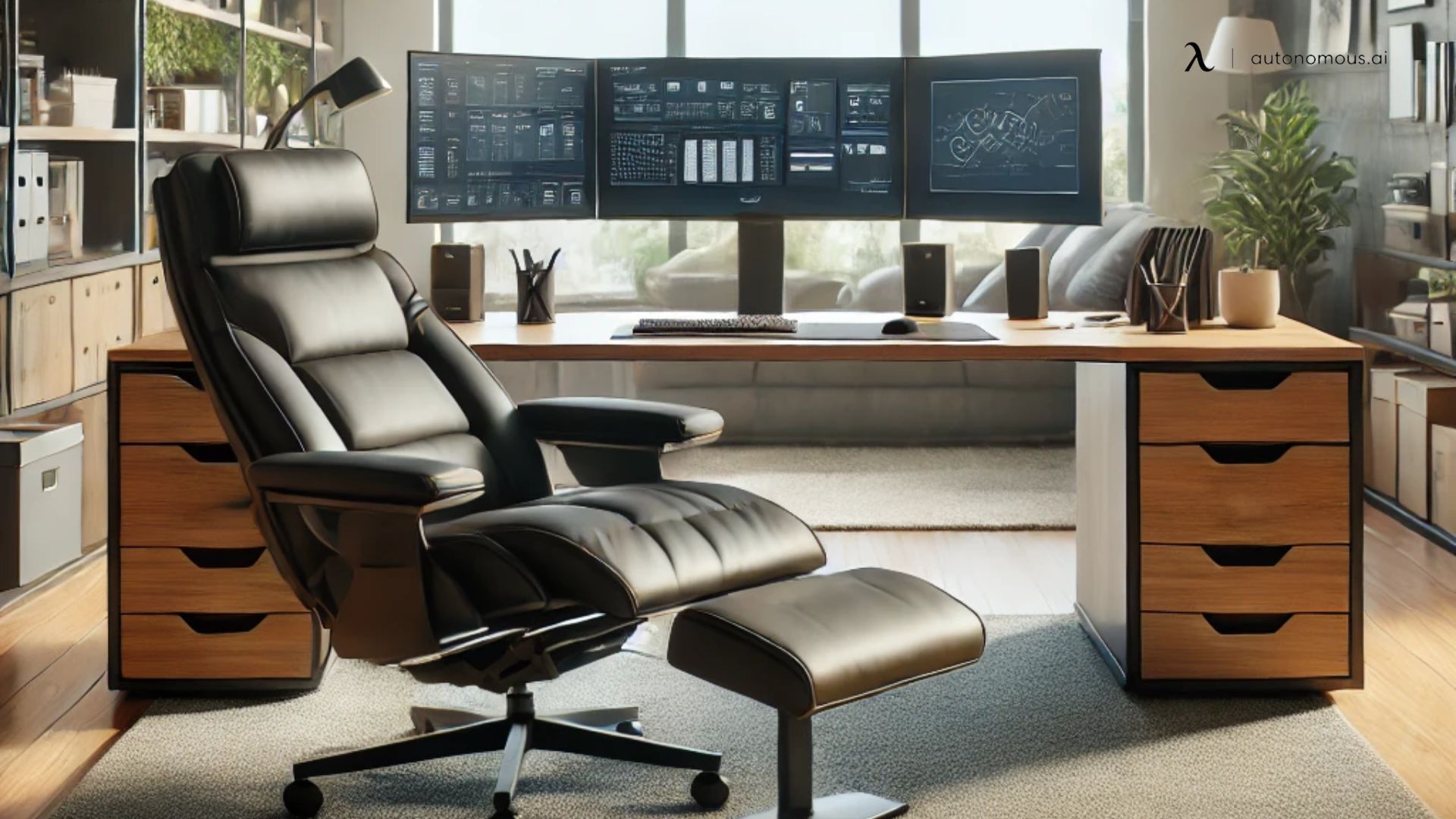
Step 6: Tips for Customizing Your Recliner Desk Setup
Customizing your setup ensures it meets your unique needs. Consider these ideas for personalization:
- Color and texture: Incorporate colors and textures that are soothing or inspiring. Soft cushions or throw blankets can add a touch of coziness.
- Sound system: Adding a small speaker or headphones can provide background music, creating a relaxing environment for work or breaks.
- Cable management: Use cable clips or organizers to keep cords and wires out of the way, maintaining a clean and tidy workspace.
Think about your daily routines and personalize the space with items that make your workday easier and more enjoyable.
Step 7: Maintenance and Upkeep of Your Recliner Desk Setup
Regular maintenance of your recliner computer setup will prolong its lifespan. Clean the recliner and desk frequently, check for loose screws, and monitor the wear and tear of accessories. Proper maintenance will ensure your setup remains comfortable and functional for years to come.
Tips for Better Ergonomics and Comfort
1. Use a Recliner with Adjustable Back and Lumbar Support
- Adjustable back support: A recliner that allows you to adjust the angle of the backrest can help you find the most comfortable position for different tasks. A recline angle of around 100-110 degrees is generally ideal for typing, while a more reclined position can be more comfortable for reading or taking breaks.
- Lumbar support: Opt for a recliner that offers built-in lumbar support, or consider adding a lumbar cushion. Proper lumbar support helps maintain the natural curve of your spine, reducing the risk of back pain.
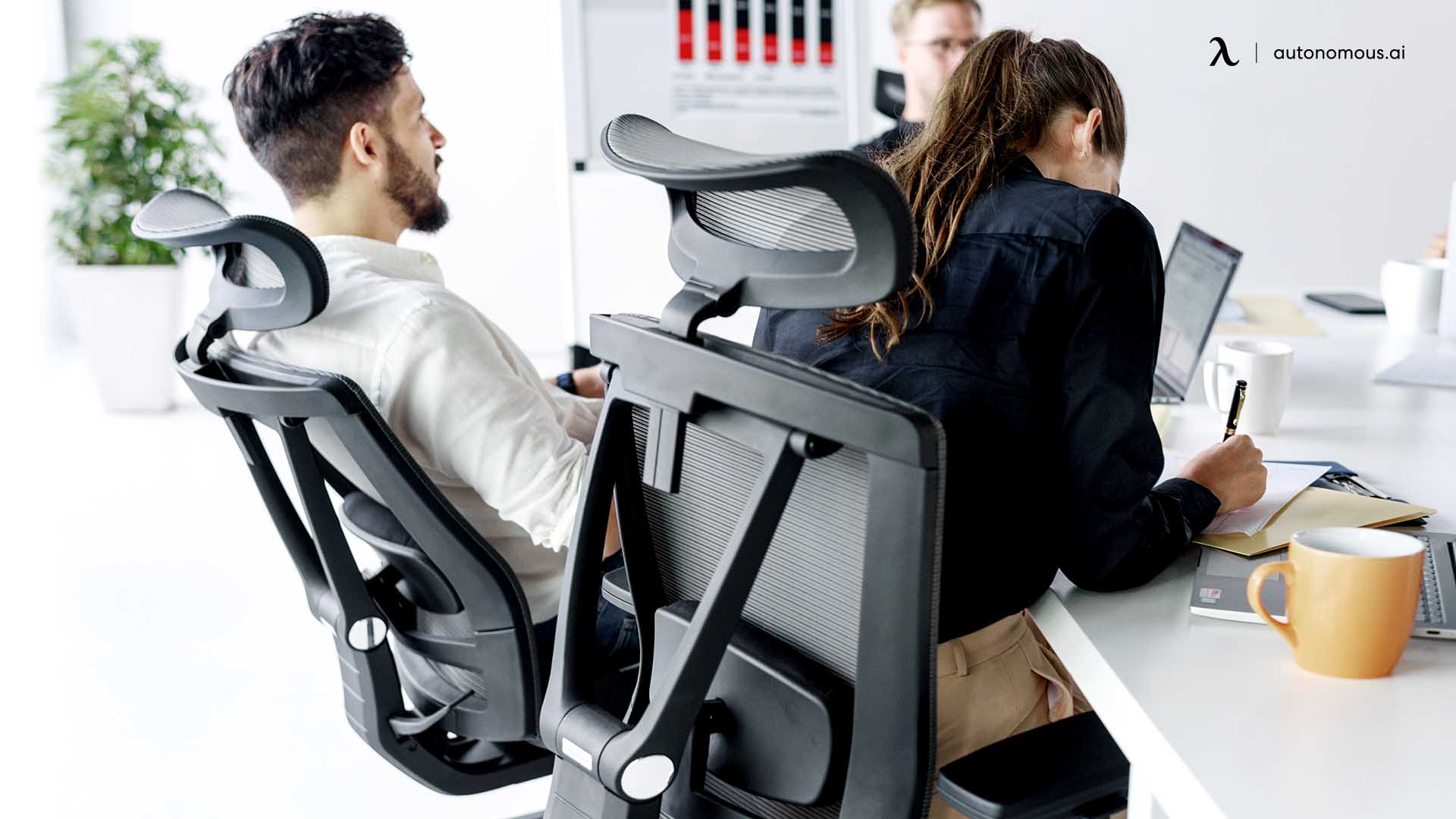
2. Position Your Monitor at Eye Level
- Optimal monitor height: Your monitor should be at eye level, with the top of the screen at or just below your eye height. This prevents you from having to tilt your head, which can strain your neck.
- Distance from monitor: Keep the monitor about an arm’s length away from you. This distance is comfortable for viewing and reduces eye strain.
3. Keep Your Feet Supported
- Use a footrest: A footrest can support your feet, promoting better circulation and reducing pressure on your lower back. Adjustable footrests can be helpful, allowing you to find the right height for your legs.
- Floor cushion or ottoman: If your recliner does not have a built-in footrest, consider an ottoman or cushion to prop up your feet. This can help you maintain a comfortable leg position.
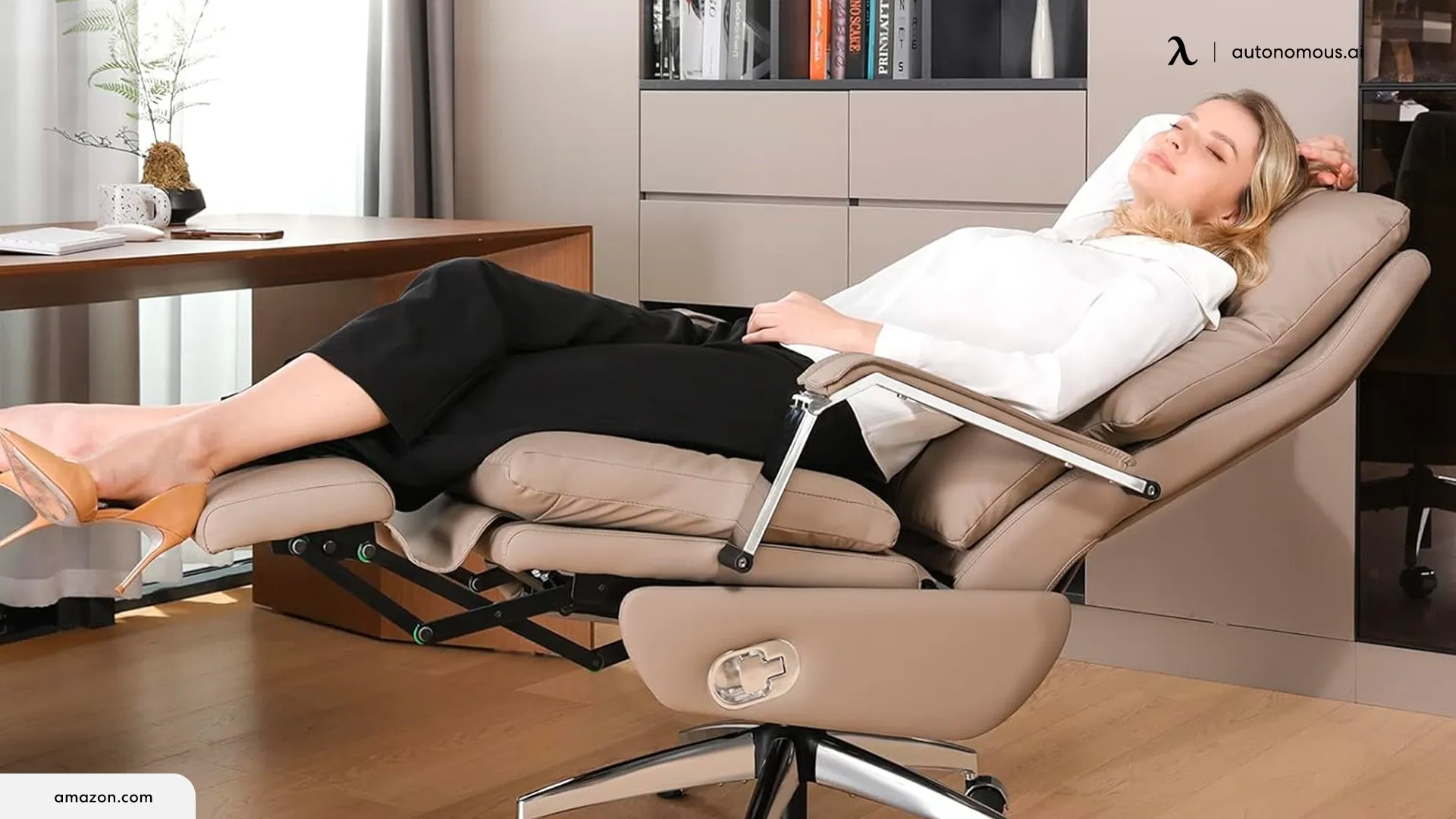
4. Maintain a Neutral Wrist Position
- Ergonomic keyboard tray: Position your keyboard and mouse so that your wrists remain in a neutral, straight position. This helps reduce strain on your wrists and forearms.
- Wrist support: Use a wrist rest if necessary. Keeping your wrists straight and level with your elbows minimizes the risk of repetitive strain injuries like carpal tunnel syndrome.
5. Optimize Your Desk Layout
- Keep essentials within reach: Arrange your desk so that frequently used items are easily accessible without straining. This minimizes the need to reach excessively and allows you to maintain good posture.
- Organize your workspace: Clutter can cause distractions and stress. Keep your workspace organized with desk organizers and cable management solutions. This helps create a cleaner, more productive environment.
6. Incorporate Movement Breaks
- Switch between sitting and standing: If you have a standing desk, alternate between sitting in your recliner and standing throughout the day. This reduces the strain on any one part of your body and promotes circulation.
- Stretch regularly: Take short breaks every 30 minutes to stretch your arms, neck, and legs. This helps reduce muscle tension and keeps your body feeling relaxed and energized.

7. Pay Attention to Lighting
- Minimize glare: Position your monitor away from windows and light sources that could cause glare. Excessive glare can lead to eye strain and discomfort.
- Use task lighting: Having focused lighting can make it easier to see your work without straining your eyes. Consider using an adjustable desk lamp that allows you to direct light where you need it most.
8. Customize Your Recline Angle for Comfort and Productivity
- Find your ideal angle: Experiment with different recline angles for various tasks. A more upright position may be best for focused work, while a reclined position is ideal for reading or relaxing.
- Adjust as needed: Don’t be afraid to change the recline angle throughout the day. Moving between positions can reduce fatigue and help keep you comfortable for longer periods.
9. Maintain Good Posture
- Sit back and relax: Recliners are designed to support your entire body, so take advantage of this. Sit back, allowing the chair to support your spine and reduce pressure on your back muscles.
- Keep your shoulders relaxed: Avoid hunching your shoulders. Keeping your shoulders relaxed and down can prevent tension in your upper back and neck.
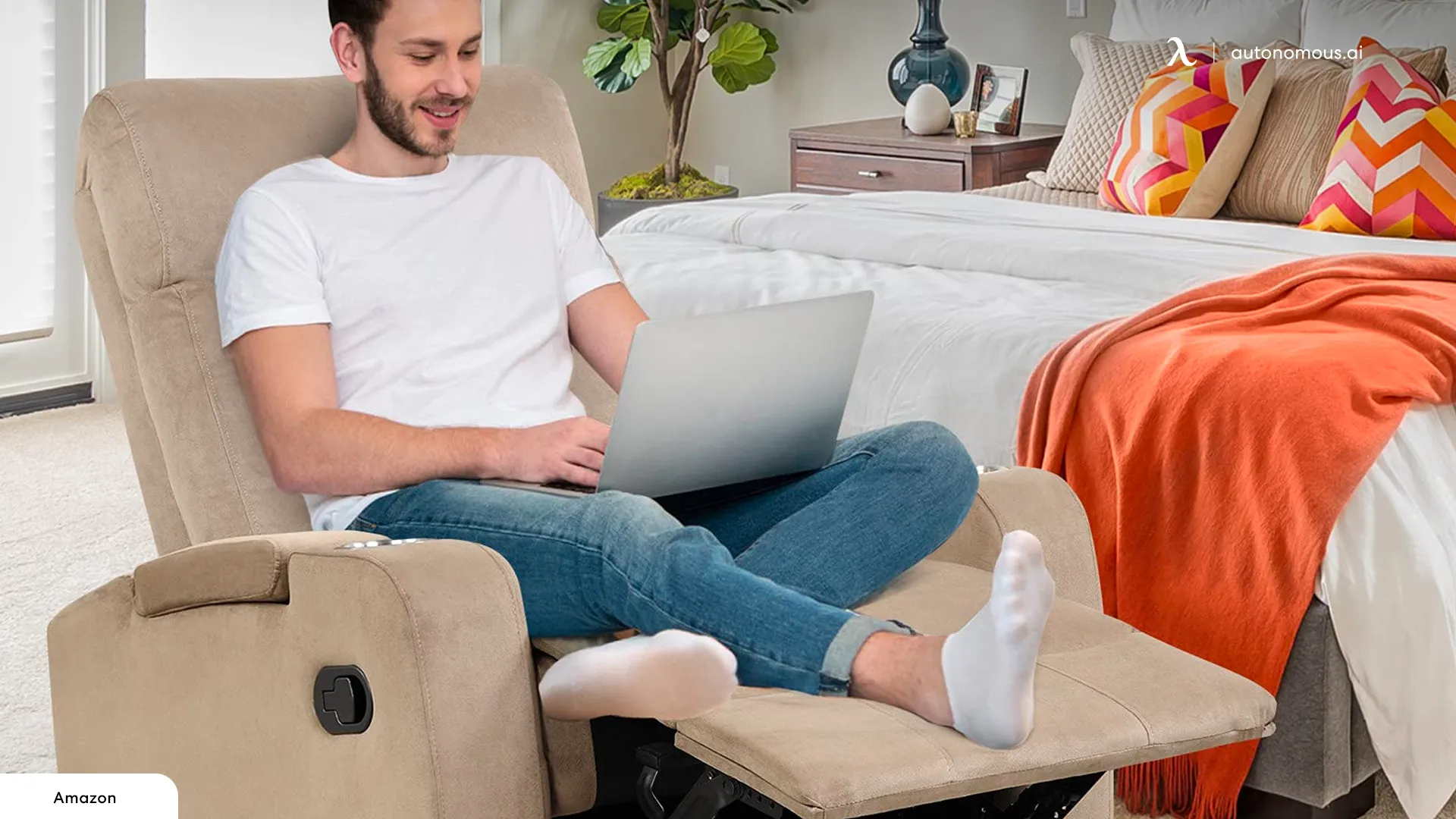
Incorporating these ergonomic tips into your recliner desk setup can help you create a comfortable and supportive workspace that enhances both your health and productivity. By paying attention to your posture, using supportive accessories, and making small adjustments as needed, you can enjoy a setup that’s tailored to your needs.
Conclusion
A recliner desk setup can be a game-changer for your home office experience. By following these guidelines and customizing your space to your preferences, you can create a comfortable, productive, and inspiring workspace that promotes both physical and mental well-being.
Bleiben Sie mit uns in Verbindung!
Abonnieren Sie unsere wöchentlichen Updates, um über unsere neuesten Innovationen und Community-Neuigkeiten auf dem Laufenden zu bleiben!


/https://storage.googleapis.com/s3-autonomous-upgrade-3/production/ecm/230914/bulk-order-sep-2023-720x1200-CTA-min.jpg)

/https://storage.googleapis.com/s3-autonomous-upgrade-3/production/ecm/230824/EthanJohnson-ffebe8b4-4650-46f9-a3b3-ed980acaad86.jpg)